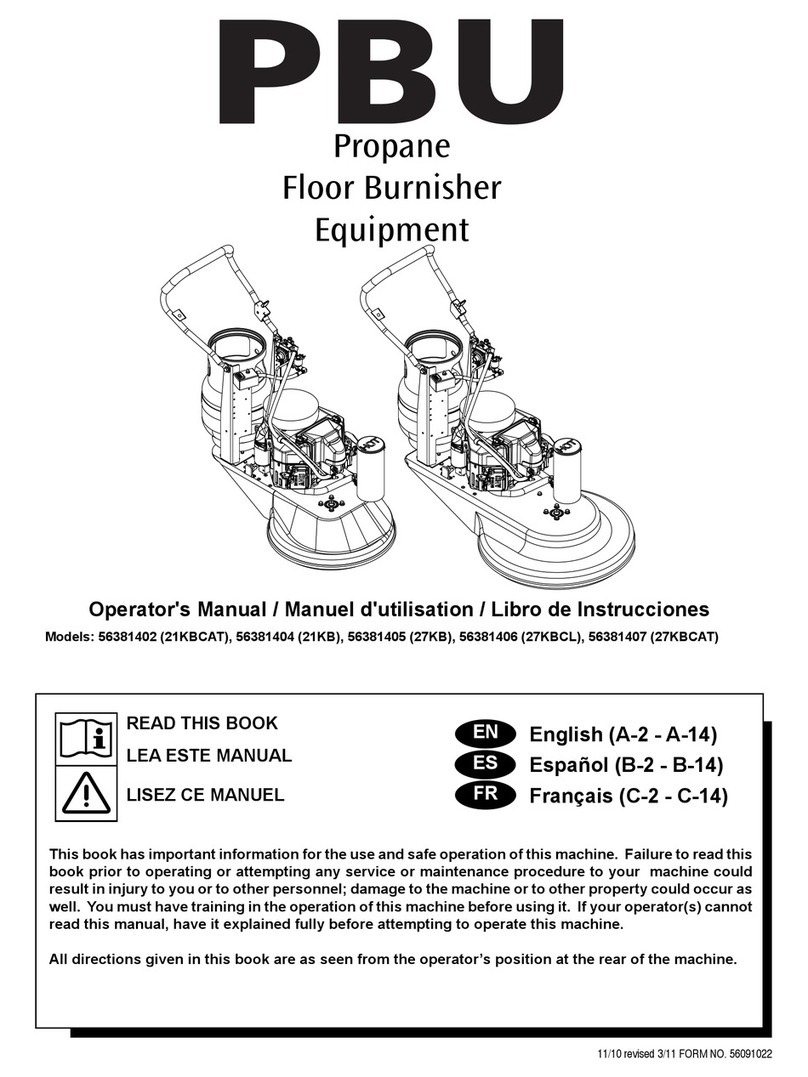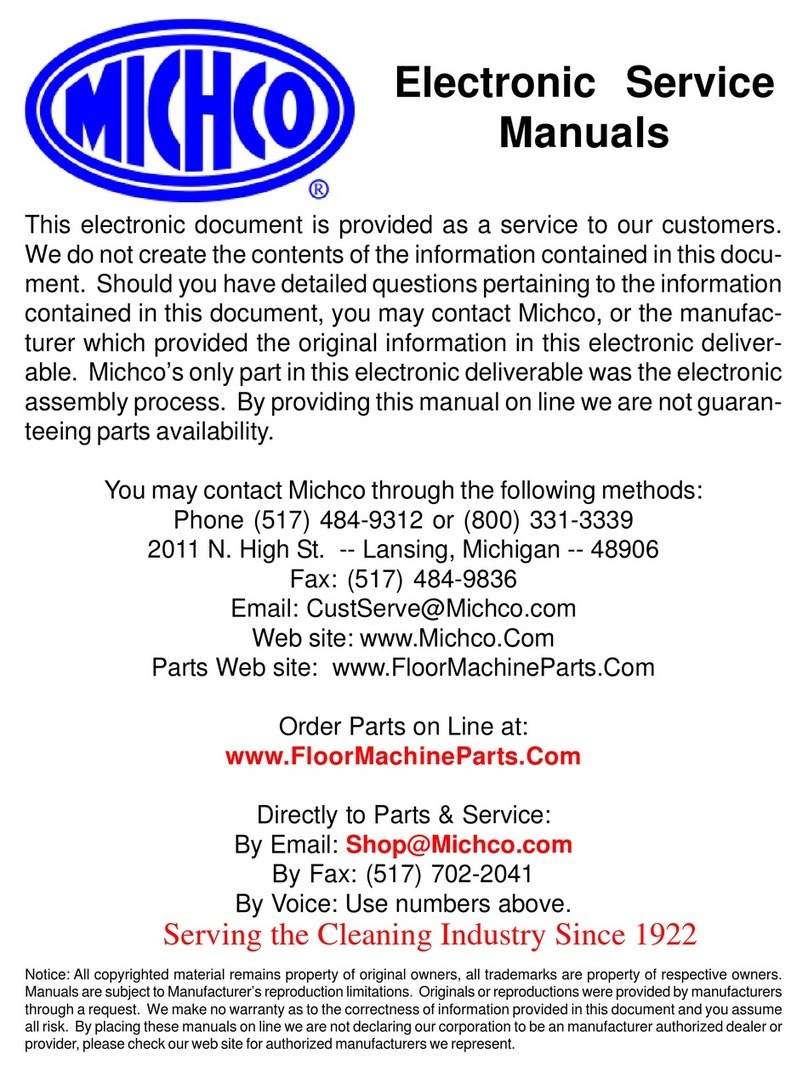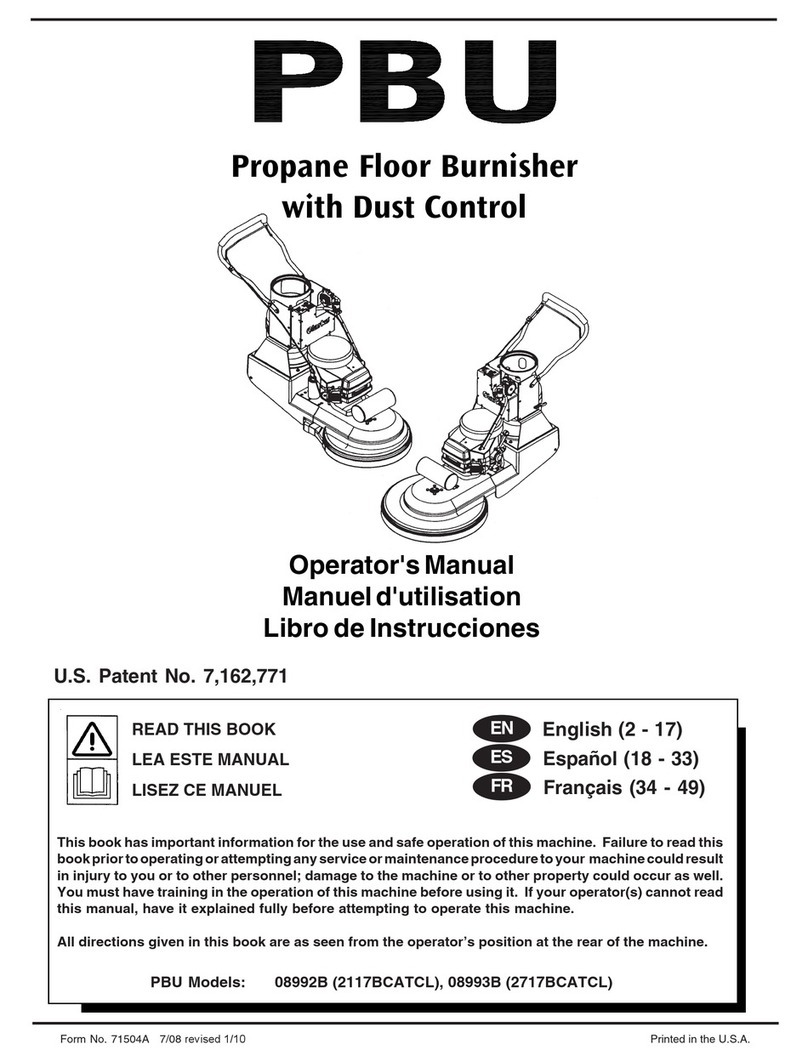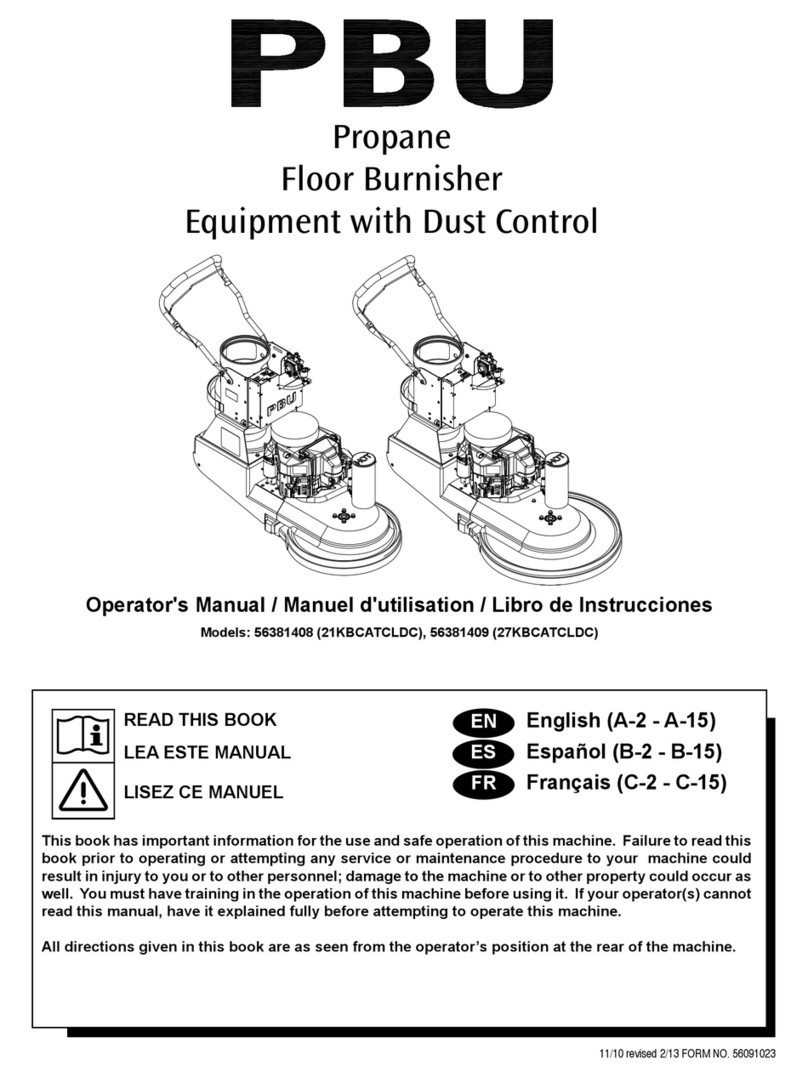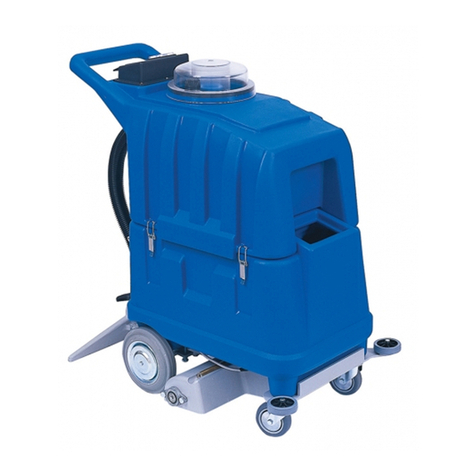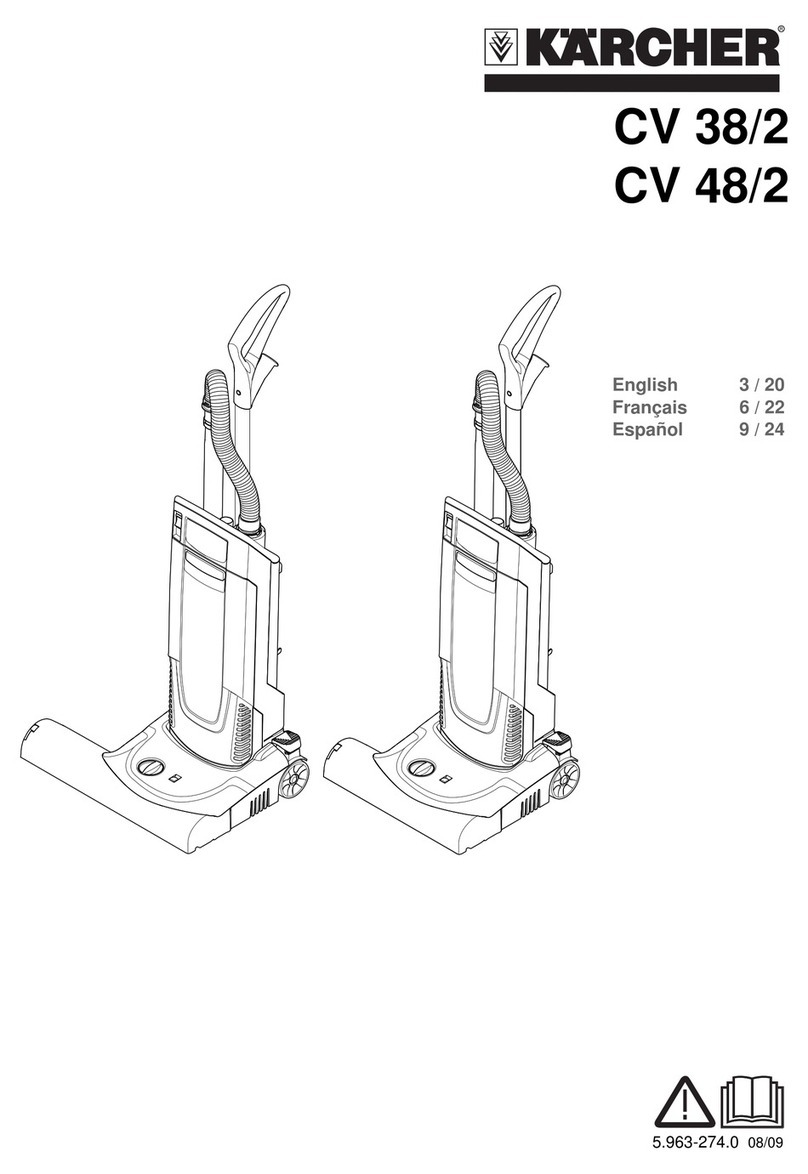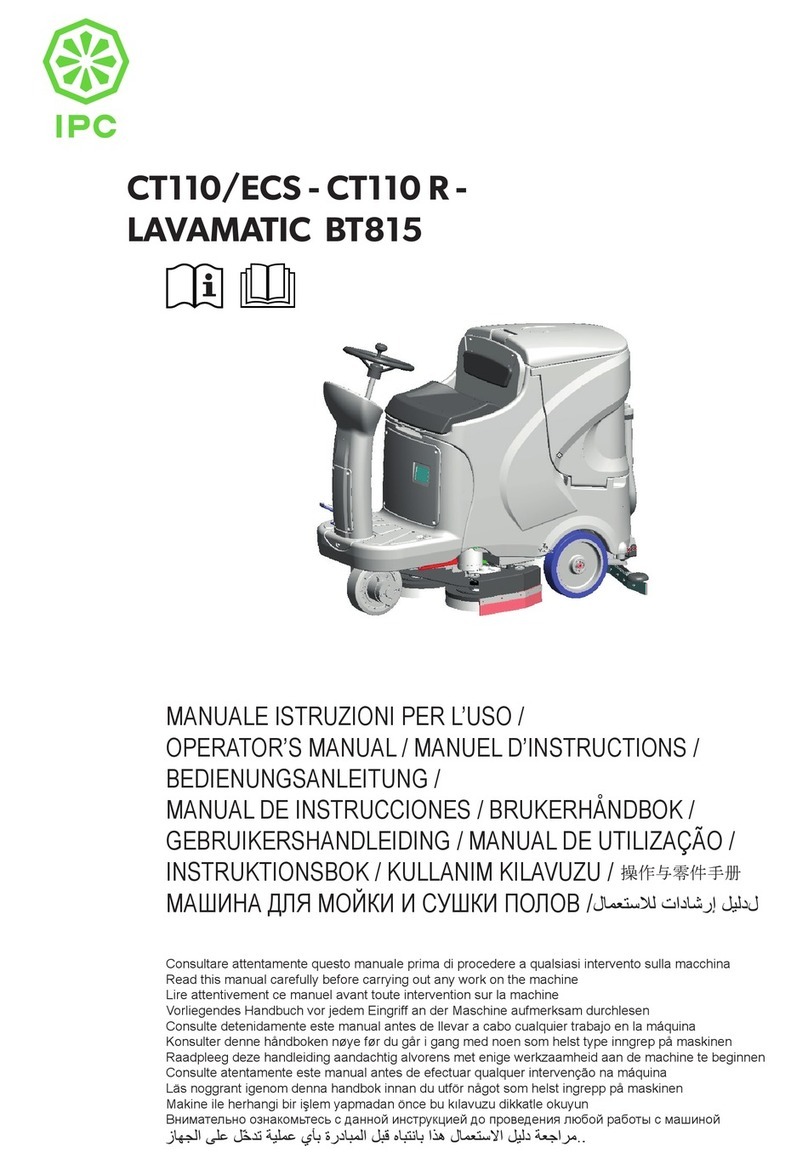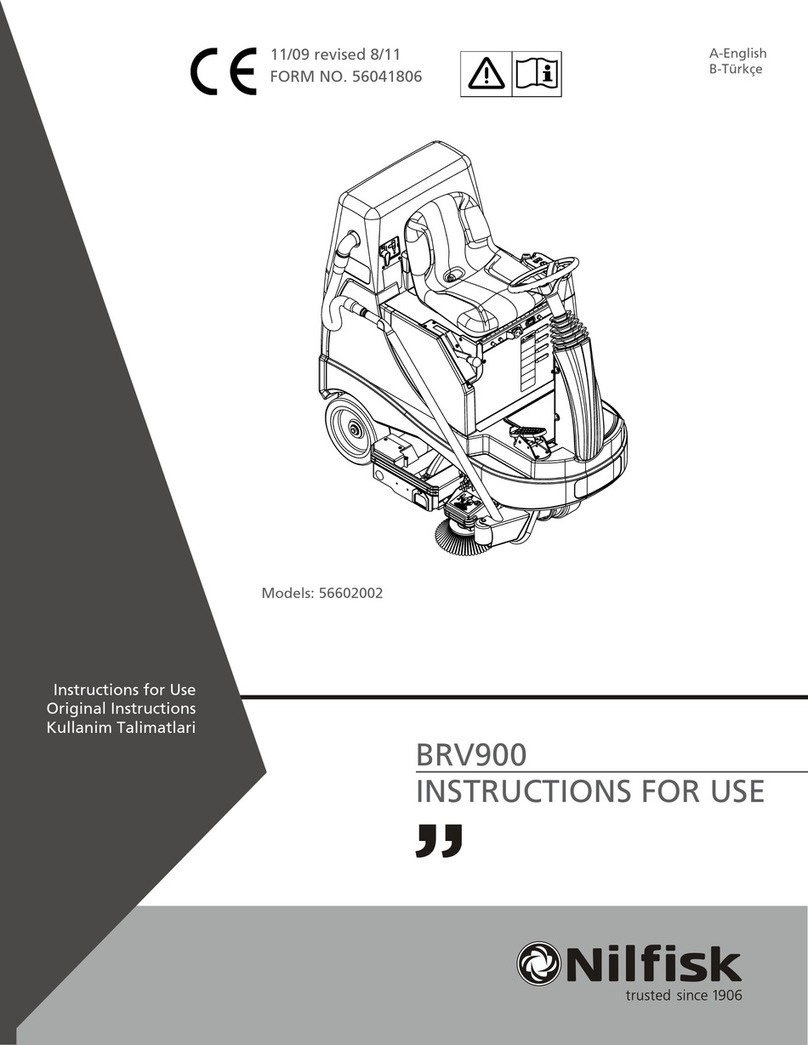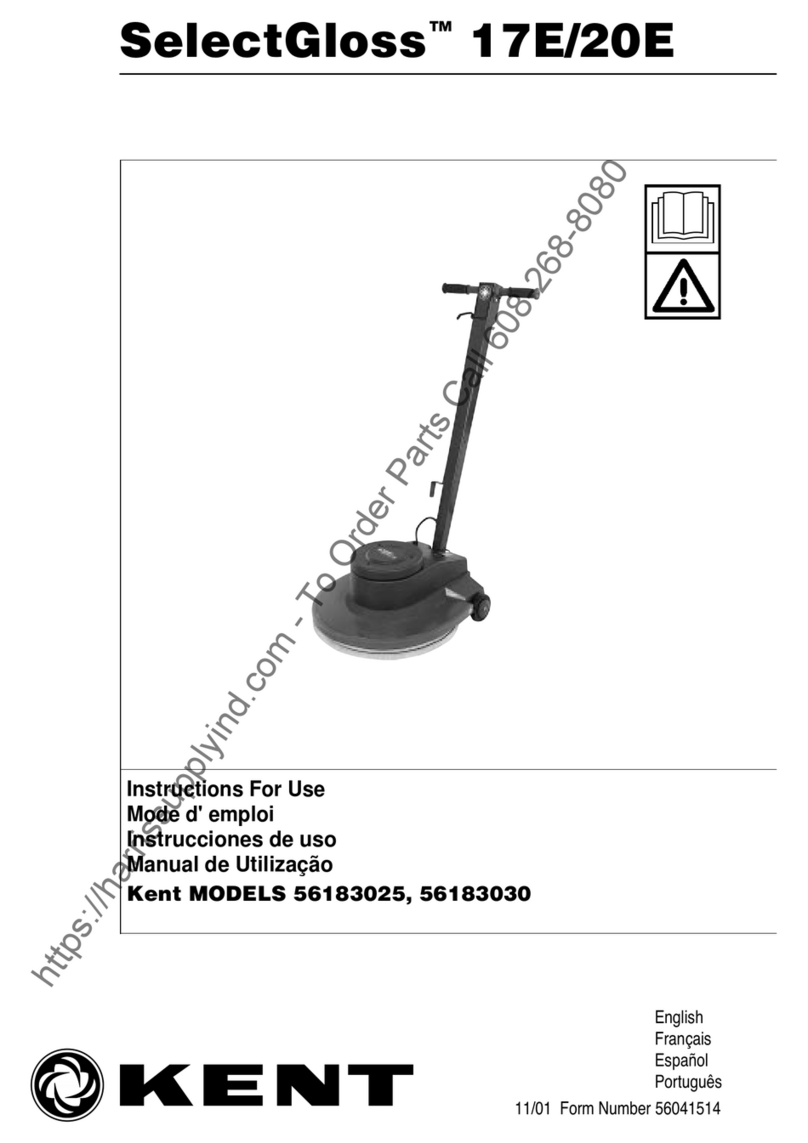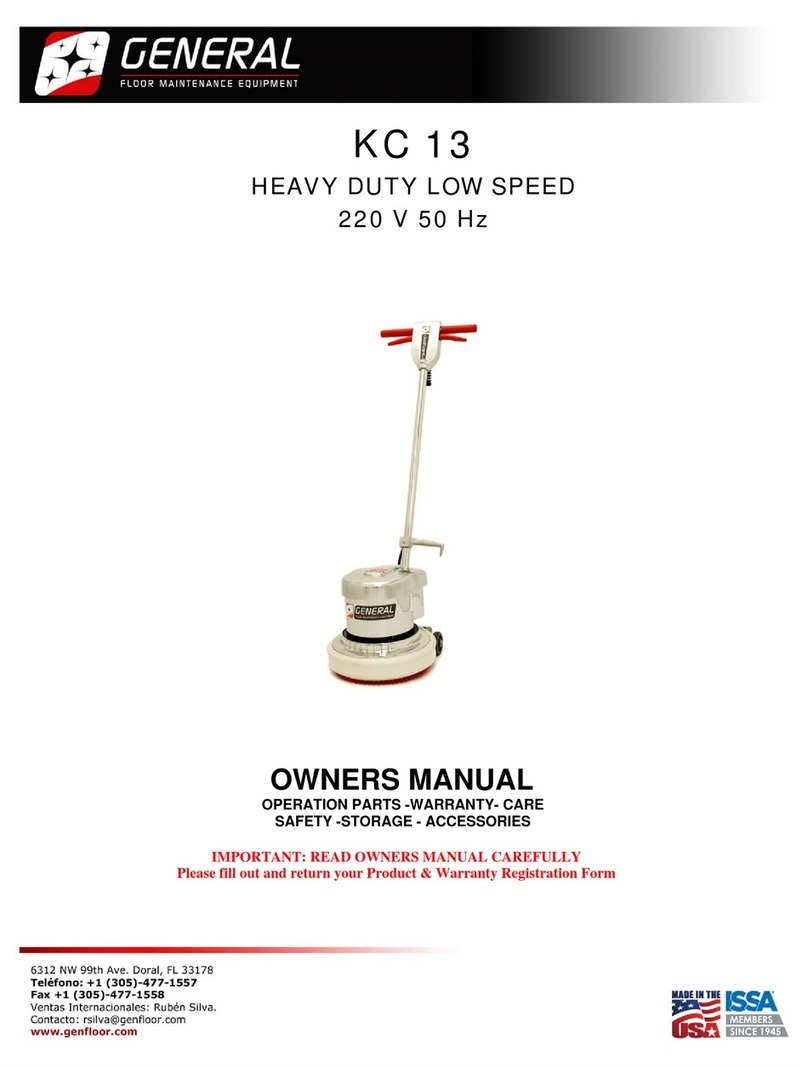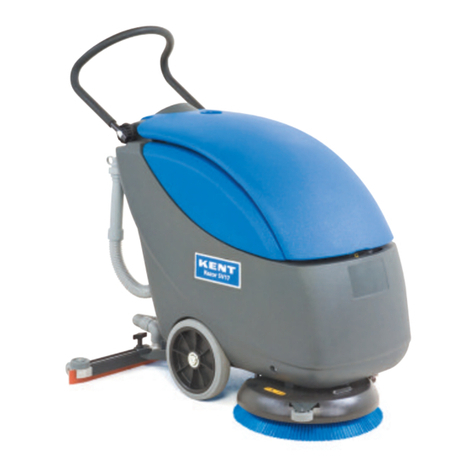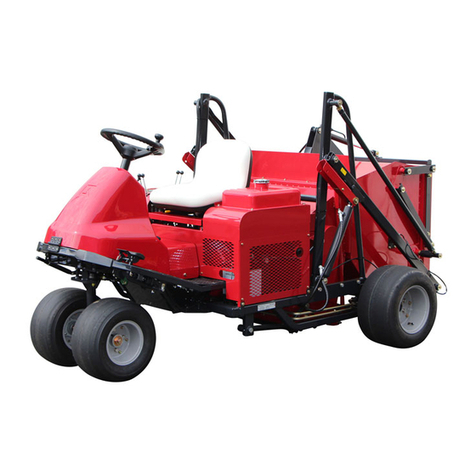PBU 08001B User manual

Propane
Floor Burnisher
Equipment
Form No. 71503A 7/08 Printed in the U.S.A.
Operator's Manual
Manueld'utilisation
Libro de Instrucciones
This book has important information for the use and safe operation of this machine. Failure to read this
bookpriortooperatingorattemptinganyserviceormaintenanceproceduretoyour machinecouldresult
in injury to you or to other personnel; damage to the machine or to other property could occur as well.
You must have training in the operation of this machine before using it. If your operator(s) cannot read
this manual, have it explained fully before attempting to operate this machine.
All directions given in this book are as seen from the operator’s position at the rear of the machine.
English (2 - 15)
Español (16 - 29)
Français (30 - 43)
READ THIS BOOK
LEA ESTE MANUAL
LISEZ CE MANUEL
ES
EN
FR
PBU Models: 08001B (2113E), 08002B (2113ECL), 08012B (2113BCAT),
08945B (2117BCAT), 08947B (2717BCAT), 08987B (2717B),
08989B (2117B)

Page 2
PBU
Operator's Manual (EN) - Propane Burnisher
EN
ENGLISH
Engine Emissions and CO Safety........................................................................3
Specifications .....................................................................................................10
Operator Safety Instructions ..............................................................................11
Introduction ........................................................................................................12
Propane Safety Information................................................................................13
How to Operate the Machine .............................................................................14
Maintenance and Adjustments ...........................................................................14
Trouble Shooting ................................................................................................15
SECTION II - Parts Manual
Frame Assembly ................................................................................................46
Handle Assembly ...............................................................................................48
Engine Assembly (17 HP)..................................................................................50
Engine Assembly (13 HP)..................................................................................52
12 Volt Fuel System ...........................................................................................54
Vacuum Fuel System .........................................................................................55
Bearing Assembly ..............................................................................................56
Pad Driver Assembly .........................................................................................57
Belt Selection Chart ...........................................................................................58
Pulley Chart .......................................................................................................58
Electrical Schematic 120V AC System ..............................................................59
Electrical Schematic 17 HP Twin 12Vdc ...........................................................60
Table of Contents
This Owner's Manual/Safety Procedures Guide has been prepared for the promotion of educational purposes only and
does not claim or assume any responsibility for the operator's actions or safety. To be completely aware of what local
authorities may require, contact the Fire Marshal of your community.
DANGER: It is the owner/operator's responsibility to ensure that the air-exchange system
installed in any location where a propane floor care machine is being operated is of suffi-
cient capacity and quality to support the use of such a machine. OSHA and other County,
State, or Federal Agencies publish guidelines on this subject that are usually most readily
found in the possession of the respective owners and/or parent companies of any location
or chain of locations. Failure on the part of the owner/operator to ensure that a propane
floor care machine can be operated safely in a given location may lead to injury, sickness
or even loss of life.

PBU
Operator's Manual (EN) - Propane Burnisher Page 3
EN
ENGLISH
Engine Emissions and CO Safety
The purpose of this document is to provide information on:
· The potential effects of CO exposure;
· The methods to reduce the risk of CO poisoning;
· The methods used to determine the amount of potential exposure to CO produced by equipment.
DANGER: All LPG (Liquid Propane Gas) powered engines, including this engine, produce Carbon Monoxide
(CO). It is a LETHAL POISON that is a colorless, odorless, tasteless, and non-irritating gas. It is produced by
incomplete combustion of carbonaceous material such as propane (LPG).
Failure to provide for proper venting of CO produced during the operation of combustion powered engines may
result in SERIOUS INJURY OR DEATH to the operator and those in the contaminated area.
The effects of CO can be experienced at different exposure levels, depending on the health of the individual.
Conditions that affect the tolerance of the individual are smoking, age, temperature, humidity, and other
conditions.
WARNING: Read and understand The Operators Manual completely before using this machine
This document explains how CO produced can be managed to reduce the risk of carbon monoxide poisoning.
All distributors, owners, and operators should be aware of the potential effects of CO and the methods used to
prevent over exposure.
We are dedicated to our customers, their safety, and providing information, services, and products that meet
those needs.
Information provided in this document is current as of the date written November 1997.

Page 4
PBU
Operator's Manual (EN) - Propane Burnisher
EN
ENGLISH
Document Overview
The information provided in the following overview has been condensed to provide the
reader with a summary of the material presented.
Potential Effects of CO Exposure
•Work place/industry guidelines for CO exposure limits vary substantially from region to region
(OSHA) Permissible Exposure Limit (PEL) for CO is 50 ppm, as an 8-hour time weighted average.
•Definition of CO effects - The toxic effects of carbon monoxide in the blood are the result of tissue
hypoxia (lack of oxygen). The severity depends on the state of activity of the individual and his tissue
oxygen needs.
Methods to Reduce The Risks of CO Poisoning
•Air Exchange and CO Diffusion - CO does not mix with air on its own. Air currents can “stir” the CO
and dilute the concentration values by mixing it with the available air. When using equipment over a large
area in a short time “stirring” occurs as you walk.
•Application Considerations (Burnishing versus Stripping) - When activity is concentrated to a smaller
area as in a stripping application, air “stirring” must be forced by the use of fans to reduce the risk of
high concentrations of CO.
•Air Quality Monitoring – Deployment of a monitor/detector is essential for the safe operation of any
equipment that has the potential to produce CO.
•Room Size and Time Estimations - The concentration and volume of CO production, the size of the
area and the amount of air exchange are factors involved with determining safe time limits for operation
in a specific room size.
•Maintenance of Equipment - LPG engines are dependent on engine tune up, and air filter replacement.
CO concentration (production) skyrockets when the air to fuel ratio becomes fuel rich. Follow the
recommended Maintenance Schedule for the engine.
•Safety Equipment Available. - Envirogard automated fuel to air ratio monitoring and regulation
providing an optimum combustion, three-way type catalytic converter to scrub CO, Hydro Carbons (HC),
and Nitrous Oxide (NOx) from the engine exhaust providing the lowest possible emissions, high cubic feet
per minute (CFM) fans (forced air mixing), and digital combustion analyzers for tail pipe emissions
monitoring.

PBU
Operator's Manual (EN) - Propane Burnisher Page 5
EN
ENGLISH
Engine Emissions and CO Safety
Potential Effects of CO Exposure
· Work place/industry guidelines for CO exposure limits
· Definition of CO effects
Work place/industry guidelines for CO exposure limits
Limits for permissible exposure to CO vary substantially from region to region. City, State, and Industry require-
ments should be consulted prior to use of any equipment.
The current Occupational Safety and Health Administration (OSHA) Permissible Exposure Limit (PEL) for CO is 50
ppm, as an 8-hour time weighted average (TWA). This is computed by making measurements at intervals over 8 hours,
then adding the sums of the concentrations and the intervals, and dividing by 8 hours. For example:
Time Interval PPM
8:00-9:00 1 HR 100
9:00-10:00 1 HR 25
10:00-11:00 1 HR 25
11:00-12:00 1 HR 50
12:00-1:00 1 HR 50 400ppm/8HR=50ppm TWA
1:00-2:00 1 HR 50
2:00-3:00 1 HR 50
3:00-4:00 1 HR 50
Time intervals = 8 HR ppm = 400
The current National Institute for Occupational Health and Safety (NIOSH), immediately dangerous to life and
health concentration (IDLH) recommended level for CO is 1,200 ppm. NIOSH defines the IDLH exposure level as the
concentration that could result in irreversible health effects or death, or prevent escape from the contaminated environ-
mentwithin 30 minutes.
Definition of CO effects
The toxic effects of carbon monoxide in the blood are the result of tissue hypoxia (lack of oxygen). carbon monoxide
combines with hemoglobin to form carboxyhemoglobin. Since CO and oxygen react with the same group in the hemoglo-
bin molecule, carboxyhemoglobin is incapable of carrying Oxygen. The affinity of hemoglobin for CO is 200 to 240 times
greater than for oxygen. The extent of saturation of hemoglobin with CO depends on the concentration of the gas, the
quantity of inspired air and on the time of exposure. The severity depends on the state of activity of the individual and
his tissue oxygen needs.
According to Harrison’s Principles of Internal Medicine 7th edition, no symptoms will develop at a concentration of
0.01% CO (100ppm) in inspired air, since this will not raise blood saturation above 10 %. Exposure to 0.05% (500ppm) for
1 hour during light activity will produce a blood concentration of 20% carboxyhemoglobin and result in a mild or
throbbing headache. Greater activity or longer exposure causes a blood saturation of 30 to 50 %. At this point head
ache, irritability, confusion, dizziness, visual disturbance, nausea, vomiting, and fainting can be experienced. Exposure
for one hour to concentrations of 0.1% (1000ppm) in inspired air the blood will contain 50 to 80% carboxyhemoglobin
which results in coma, convulsions, respiratory failure and death. On inhalation of high concentrations of CO, saturation
of the blood proceeds so rapidly that unconsciousness may occur suddenly without warning.

Page 6
PBU
Operator's Manual (EN) - Propane Burnisher
EN
ENGLISH
Methods to Reduce The Risks of CO Poisoning
•Air Exchange and CO Diffusion
•Application Considerations (Burnishing versus Stripping)
•Air Quality Monitoring
•Room Size and Time Estimations
•Maintenance of Equipment
•Safety Equipment Available
Air Exchange and CO Diffusion
The most reliable method to prevent CO Poisoning is to ensure all the CO produced is vented outside. With wood
stoves or gas heaters this is performed with ductwork that carries the exhaust and CO outside. Non-stationary
combustion type equipment must be used in such a way that CO is not allowed to rise to a harmful or dangerous level.
CO does not readily dissipate or mix with air on its own. Air currents can “stir” the CO and dilute the concentration
or ppm values by mixing it with the available air. When using equipment over a large area in a short time “stirring”
occurs as you walk, or to say it another way, your Effective Operating Zone is large. When activity is concentrated to a
smaller area as in a stripping application, the Effective Operating Zone is small, and “stirring” must be forced by the use
of fans to increase the Effective Operating Zone and reduce high concentrations of CO.
Air exchange rates (air exchange is defined as the exhausting of internal air to the external atmosphere), the size of
the Effective Operating Zone, amount of CO produced, level of human activity, and the duration of exposure are all
factors in the determination of the production of carboxyhemoglobin and the amount of CO blood saturation.
Application considerations (Burnishing versus Stripping)
When using equipment over a large area in a short time, as in most burnishing applications, your Effective
Operating Zone is large. When activity is concentrated to a smaller area as in stripping applications, the Effective
Operating Zone is small and stirring or CO mixing MUST be forced by the use of fans to increase the Effective
Operating Zone and reduce high concentrations of CO.
Caution: air mixing in itself may not be sufficient to reduce CO to a safe level.
The Effective Operating Zone can be defined as the area covered in a given time.
Stripping is quite a different type of operation than burnishing, and carries with it substantially more hazards, as
stripping is a low movement operation compared to burnishing (less floor space for the same time). As shown in Model
1, the CO concentrations rise much quicker as the “Effective Operating Zone” is a very small area compared to the total
building size.

PBU
Operator's Manual (EN) - Propane Burnisher Page 7
EN
ENGLISH
Notice the CO concentration and the Effective Operating Zone with air exchange. The CO cloud is still concentrated
in a small area. Note the “Dividing Zone” shown above, this is the line where airflow changes direction. In Model 2, air
changes are cut in ½ as little or no CO crosses the Dividing Zone to be exhausted.
Notice the CO concentration and the Effective Operating Zone (Expanded to the Dividing zone) with air ex-
change and forced air mixing. The CO cloud is still concentrated on one side of the Dividing zone. Note the
“Dividing Zone” shown above, this is the line where airflow changes direction. In Model 3, air changes are cut in
½ as little or no CO crosses the Dividing Zone to be exhausted.
Notice the CO concentration and the Effective Operating Zone (Expanded through the Dividing zone to the second
vent) with air exchange and forced air mixing through the dividing Zone. The CO cloud is diluted with the available air in
the building. Note the “Dividing Zone” shown above, this is the line where airflow changes direction. In Model 4, air
changes are full as forced air mixing has moved and mixed the CO between all air zones.
Notice the CO concentration and the Effective Operating Zone (Expanded to the Dividing zone) with air ex-
change and forced air mixing. The CO cloud is still concentrated on one side of the Dividing zone. Note the
“Dividing Zone” shown above, this is the line where airflow changes direction. In Model 3, air changes are cut in
½ as little or no CO crosses the Dividing Zone to be exhausted.

Page 8
PBU
Operator's Manual (EN) - Propane Burnisher
EN
ENGLISH
Air Quality Monitoring
Warning: Deployment of a monitor/detector is essential for the safe operation of any equipment that has the
potential to produce CO. CO sensors/detectors became available on the mass market around 1978. At present several
brands sell in the fifty-dollar range. The main differences between the technologies involved are battery or electric and
Semiconductor or Biomimetic types. Detectors for carbon monoxide (CO) are manufactured and marketed for use in
either the home or occupational industrial settings. The detectors for home use are devices that will sound an alarm
before CO concentrations in the home become hazardous. There is an Underwriters Laboratories, Inc., performance
standard (UL 2034) for residential CO detectors. Detectors currently available on the market are battery-powered, plug-
in, or hard-wired. Some models incorporate a visual display of the parts per million (ppm) concentration of CO present in
the home. For more information on CO detectors for home use, call the Consumer Product Safety Commission Hotline at
1-800-638-2772.
CO detectors for use in residential settings are not designed for use in typical workplace settings. Monitoring
requirements in an occupational setting are different from monitoring requirements in the home. In the workplace, it is
frequently necessary to monitor a worker’s exposure to carbon monoxide over an entire work shift and determine the
time-weighted average (TWA) concentration of the exposure. It may also be necessary to have carbon monoxide
monitors with alarm capabilities in the workplace. The direct-reading instruments are frequently equipped with audio
and/or visual alarms and may be used for area and/or personal exposure monitoring. Some have microprocessors and
memory for storing CO concentration readings taken during the day. It is significant to note that some of the devices
mentioned for workplace CO monitoring are not capable of monitoring TWAs, and not all are equipped with alarms. The
appropriate monitor must be chosen on an application-by-application basis. For more information on the availability of
workplace CO monitors or their application, call the National Institute for Occupational Safety and Health at 1-800-35-
NIOSH(1-800-356-4674).
Room Size and Time Estimations for Parts Per Million (PPM) CO
The fundamental factors in area CO levels involve:
The concentration and volume of CO production;
The size of the area;
The amount of *air exchange if any;
The amount of time CO is produced.
Multiplying length, width, and height will determine the volume or cubic feet in a room. So an empty building 100ft
by 100ft with a 10ft ceiling would be 100,000 cubic ft. in size. Any material that is in the room and takes space would
reduce the cubic feet.
*Air exchange is defined as the exhausting of internal air to the external atmosphere.
The Graph above depicts the relationships of air exchange to time and CO ppm with cubic feet area and percent CO
emissions remaining constant.
1.5% CO Emission in 100,000 cubic feet w ith 480cc 14 HP Engine and complete air/CO mixing
0
50
100
150
200
250
300
350
400
450
500
0.5123456789
Time (hours)
PPM
0.0 change/hr
1/2 change/hr
1 changes/hr
2 changes/hr

PBU
Operator's Manual (EN) - Propane Burnisher Page 9
EN
ENGLISH
8 Hour Time Weighted Average (OSHA Method)
1.5 %CO 100,000cf Hours Operation 1 2 3 4 5 6 7 8
TWA (OSHA Method) 0 change/hr 34 103 206 343 514 719 959 1232
1/2 change/hr 27 70 124 183 246 311 378 445
1 change/hr 22 51 84 118 152 186 220 255
2 change/hr 15 32 49 66 83 100 117 135
Based on the CO production rates shown above the TWA would be exceeded in a 100 x 100 x 10 foot (empty) space
after 3 hours with 2 air changes per hour. (Assumes no additional CO exposure during 8 hour time period)
The Graph above depicts the relationships of air exchange to time and CO ppm with cubic feet area
and percent CO emissions remaining constant.
1.5% C O Em ission in 500,000 cubic fe e t w ith 480cc 14 HP
Engine and com plete air/CO m ixing
0
50
100
150
200
250
300
350
400
450
500
012345678910
Tim e (hours)
PPM
0.0 change/hr
1/2 change/hr
1 changes/hr
2 changes/hr
1.5% CO Em ission in 750,000 cubic feet w ith 480cc 14 HP Engine and com plete air/CO mixing
0
50
100
150
200
250
300
350
400
450
500
012345678910
Tim e (hours)
PPM
0.0 change/hr
1/2 change/hr
1 changes/hr
2 changes/hr
The Graph above depicts the relationships of air exchange to time and CO ppm with cubic feet area and percent CO
emissions remaining constant.
Based on the CO production rates shown above the TWA would be exceeded in a 100 x 500 x 10 foot (empty) space
after 6 hours with 2 air changes per hour. (Assumes no additional CO exposure during 8 hour time period)
8 Hour Time Weighted Average (OSHA Method)
1.5 %CO 500,000cf Hours Operation 1 2 3 4 5 6 7 8
TWA (OSHA Method) 0 change/hr 17 51 103 171 257 360 479 612
1/2 change/hr 14 35 62 92 123 156 189 223
1 change/hr 11 26 42 59 76 93 110 127
2 change/hr 7 16 24 33 42 50 59 67

Page 10
PBU
Operator's Manual (EN) - Propane Burnisher
EN
ENGLISH
8 Hour Time Weighted Average (OSHA Method)
1.5 % 750,000cf Hours Operation 1 2 3 4 5 6 7 8
TWA (OSHAMethod) 0 change/hr 5 14 27 46 69 96 128 164
1/2 change/hr 4 9 16 24 33 42 50 59
1 change/hr 3 7 11 16 20 25 29 34
2 change/hr 2 4 7 9 11 13 16 18
Based on the CO production rates shown above the TWAwould not be exceeded in a
100 x 750 x 10 foot (empty) space after 8 hours with 2 air changes per hour. (Assumes no additional CO
exposure during 8 hour time period)
Maintenanceof Equipment
Warning: The proper maintenance of equipment is vital to safe operation. LPG engines are dependent on
engine tune up, and air filter replacement. CO concentration (production) skyrockets when the air to fuel ratio becomes
fuel rich. Follow the recommended Maintenance Schedule for the engine found in the Engine Operator/Owner Manual as
well as the Maintenance And Adjustments schedule found in the Propane Floor Equipment Operator’s Manual that were
supplied with the equipment.
COSafety Equipment Available
• Carb Guard automated emissions monitoring will shut down the engine when high emissions are detected.
• Three-way type catalytic converter to scrub CO, Hydro Carbons (HC), and Nitrous Oxide (NOx) from the engine
exhaust providing the lowest possible emissions
• High cubic feet per minute (CFM) fans (forced air mixing)
• Digital combustion analyzers for tail pipe emissions monitoring
SPECIFICATIONS:
Model 2113E 2113ECL 2113BCAT 2117B 2117BCAT 2717B 2717BCAT
Part Number 08001B 08002B 08012B 08989B 08945B 08987B 08947B
Pad Size 21" (53 cm) 27" (68 cm)
Engine 13 hp Twin-V Kawasaki 17 hp Twin-V Kawasaki
Catalytic Muffler No No Yes No Yes No Yes
Carb Gard No No No No No No No
Clutch None Centrifugal None None None None None
Pad Speed 2100 RPM 1500 RPM
Propane Tank 20 lb. (9.1 kg) Capacity, 80% Safety fill
Auto Fuel Shutoff Yes
Low Oil Shutdown Yes
Hour Meter Yes
Sound Level 87 - 89 dB(A)
Productivity Rate 25,000 ft2/hr (2,322 m2/hr) 33,000 ft2/hr (3,066 m2/hr)
Agency Approvals EPA plus UL Approved Propane Components
CARB Certified No No Yes No Yes No Yes
(California Air Resource Board)
Weight 195 lbs. 198 lbs. 208 lbs. 220 lbs. 223 lbs. 242 lbs. 245 lbs.
Dimensions:
Length 51.5" (131.8 cm) 59" (149.9 cm)
Widith 23.3" (59 cm) 29.3" (74.4 cm)
Height 43" (109.2 cm) 43" (109.2 cm)
Warranty 2 YearS Parts & Labor

PBU
Operator's Manual (EN) - Propane Burnisher Page 11
EN
ENGLISH
DANGERmeans: Severe bodily injury or death can occur to you or other personnel if the DAN-
GER statements found on this machine or in this Owner's Manual are ignored
or are not adhered to. Read and observe all DANGER statements found in
this Owner's Manual and on your machine.
WARNINGmeans: Injury can occur to you or to other personnel if the WARNING statements
found on your machine or in this Owner's Manual are ignored or are not
adhered to. Read and observe all WARNING statements found in this Owner's
Manual and on your machine.
CAUTIONmeans: Damage can occur to the machine or to other property if the CAUTION
statements found on your machine or in this Owner's Manual are ignored or are
not adhered to. Read and observe all CAUTION statements found in this
Owner's Manual and on your machine.
DANGER: Failure to read the Owner's Manual prior to operating or attempting any service or mainte-
nance procedure to your machine could result in injury to you or to other personnel;
damage to the machine or to other property could occur as well. You must have training in
the operation of this machine before using it. If you or your operator(s) cannot read
English, have this manual explained fully before attempting to operate this machine.
DANGER: Moving parts of this machine can cause serious injury and/or damage. Do not allow contact
ofclothing,hair,hands, feet, or other body parts with the rotating pad. Keep other peopleaway
from the machine while it's in operation.
DANGER: Injury to the operator or bystanders could occur if the machine's power is on while changing
thebuffing pad or making machineadjustments. Nevertryto change the buffingpadorattempt
to make machine adjustments while the engine is running.
DANGER: Cigarettelighters, pilot lightsandanyother source ofignitioncancreate an explosionifitcomes
in contact with propane. Propane is a highly flammable fuel. All sources of ignition should be
extinguishedor removed entirelyifpossiblefrom the workarea. DONOTSMOKE in thevicinity
of a propane buffer.
DANGER: This machine emits carbon monoxide. Asphyxiation could occur if the unit is used in an area
with poor or inadequate ventilation. Operate machine in a well ventilated area only. If a
headache develops, shut off the machine. Have it checked for carbon monoxide emissions
by a qualified shop before using it again.
DANGER: Dangerouscarbonmonoxideemissionsfrom this machine are greatly increased due to a dirty
combustion air cleaner. Follow the engine's manufactureres air cleaner service instructions.
DANGER: Propane is highly flammable. If you smell propane gas, shut off the machine and move it
outside. Determine and repair the source of the leak before restarting. NEVER vent propane
gasinsideabuilding. Disconnectthe fuel line from the tank, remove the tank from the machine
and then store the propane tank in a secrue storage cabinet outside the building. It is
UNLAWFUL to store a propane bottle inside a building.
WARNING: Long or continuous exposure to high noise levels may cause permanent hearing loss.
Always wear hearing protection while using this machine.
WARNING: Injury to the eyes and/or body can occur if protective clothing and/or equipment is not worn
while using this machine. Always wear safety goggles and safety clothing while using this
machine.
OPERATOR SAFETY INSTRUCTIONS

Page 12
PBU
Operator's Manual (EN) - Propane Burnisher
EN
ENGLISH
Introduction
WARNING: Severe burn or injury could occur if you touch the hot muffler or exhaust pipe. Do not touch
the hot muffler or exhaust pipe.
WARNING: Anyalterationsor modifications of this machine could result in damagetothemachineorinjury
to the operator or other bystanders. Alterations or modifications not authorized by the
manufacturer voids any and all warranties and liabilities.
WARNING: To avoid injury or property damage, do not leave the machine where it can be tampered with
or started by persons untrained in its operation. You must have training in the operation of
this machine before using it. DO NOT leave the machine running unattended.
WARNING: Substantial damage to the floor, the machine, or personnel may result if the machine is
operated with the pad off center, damaged or missing. Do not operate the machine if the pad
is off center, damaged or missing.
WARNING: Operating a machine that has loose parts could result in injury or property damage. Do not
operate this machine if there are loose parts. Inspect the machine for loose parts frequently.
This will promote safe operation and a long life for the machine.
WARNING: Vibration from machinery may cause numbness or tingling of the fingers in certain people.
Smoking, dampness, diet, and heredity may contribute to the symptoms. Wearing warm
clothing, gloves, exercising and refraining from smoking can reduce the effects of vibration.
If the symptoms still persist, discontinue operation of the machine.
This propane floor care equipment is manufactured in
two basic concepts: the buffer/burnisher and the floor
stripper. Both of these designs are truly PORTABLE
equipment. Propane buffers are best defined as ultra
high speed buffers with the staying power to produce
superior high gloss floor surfaces. Upon contact with the
floor, the buffer should always be kept moving. The
speed at which you walk will determine the results that
you will obtain. Slower speeds create more heat and
therefore more shine. A moderate pace is recommended
for best results and safe operation. NEVER RUN WITH
THE BUFFER!! While a credible shine will still result, the
danger of trying to stop the machine in an emergency
situation is unacceptable. When buffing, avoid loose tile,
electric outlets, door thresholds and any object which
may come in contact with the pad other than the floor
itself. REMEMBER, the pad is turning very rapidly.
Proper care and maintenance will protect your invest-
ment and keep your machine serving you for many years
to come. It is essential that these issues are closely
followed:
CAUTION: Overfilling the propane tank is the
number one cause of problems with a
propane machine. This can cause
the engine to run poorly or not at all.
In addition, overfilling allows liquid propane to
enter the fuel control system, possibly ruining
the lockoff/regulator assembly. This voids the
warranty on affected parts of the machine. To
avoid problems, read and understand fully, the
section "Filling and Storing Propane Tanks."
OVERHEATING
is a major cause of engine failure.
Keep the cooling air bonnet filter clean. Protect your
machine; don't allow wax dust/lint to build up on the
cooling fins of the engine cylinder(s). A good high
pressure spray wash directed at the fins
when the
engine
is cold will prevent this from happening.
LOW OIL AND DIRTY OIL
account for most of the
other failures. It's recommended to change the oil
on
a regular schedule
, perhaps exceeding that which is
found in the engine manufacturers' manual. Check-
ing the oil daily, before putting the machine to work, is
a good habit to get into and could save you the
downtime and expense of replacing the engine due
to oil starvation. AFTER AN OIL CHANGE, MAKE
SURE YOU HAVE REPLACED THE OIL SUPPLY
BEFORE RESTARTING THE ENGINE.

PBU
Operator's Manual (EN) - Propane Burnisher Page 13
EN
ENGLISH
Propane Safety Information
Facts About LP Gas - Propane
As a fuel, Propane gas is unmatched for both safety and
dependability. It has been used as a domestic household
fuel for over half a century, and for over thirty years as an
internal combustion engine fuel. Propane is a highly
flammable fuel that is contained under pressure as a
liquid. Vaporized gas has a similar explosive force to
gasoline and mixtures as low as 2% LP Gas to air may be
ignited in a closed environment. Care should be
exercised to avoid escaping vapor as it can freeze skin
and cause frost bite. Vaporized fuel is heavier than air and
will collect in the lowest confined space available.
Facts About Propane Tanks
Propane tanks are constructed according to ASME or
Federal DOT #4ET20 pressure safety codes. Including the
tank, all valves and fittings are UL Listed. Propane gas is
noncorrosive and will not rust the inside of a tank. Should
the tank exterior become damaged or rusted, discontinue
use.
DO NOT
tamper with tank gauges or safety relief
valves.
NEVER
use a tank not intended for use with a
propane buffer.
DO NOT
substitute tanks that are used
with a barbecue grill, etc. We recommend having propane
tanks tested once a year by an authorized National LP Gas
Association sanctioned propane dealer.
The fuel tank is supplied directly from the manufacturer
and is void of fuel. This tank must be purged at the time of
the first fill. Local fuel vendors should be familiar with this
operation and will provide this service.
RecommendedPurgeProcedures
How to purge new LP-Gas Buffer cylinders equipped with
the Overfill Prevention Device:
New containers may contain vapor, air, or other
contaminants. It is essential that these be removed before
filling the container and placing it into service. Air in the
container will cause abnormally high pressure, with the
result that the pressure relief valve may open.
Air in the
system is also likely to cause lean mixture, making
ignition difficult.
If a cylinder is suspected of being
depressurized or open to the atmosphere for a period of
time, it must be re-purged as if it were a new container.
To purge a container, the following steps should be
taken.
Purging of containers should be performed in an approved
area (see NFPA #5 8) using NPGA #13 3.89(a) procedure.
1. Determine if the container pressure is zero. Should the
cylinder contain only pressurized air, the air may be vented
directly to the atmosphere through the service valve using an
adapterand the outagevalve.
2. Pressurize the container to approximately 15 psig with LP-
gas vapor.
Never purge with liquid LP-gas!
To do so
will cause the moisture vapor to chill and remain in the
cylinder. LPgas liquid also expands 270 times to
vapor making the purge process ineffective.
Use LP-
gas vapor only!
3. Make the connection to the quick coupler (A purge manifold
system is most effective). Fully open the cylinder service
valve as well as the outage valve. Vent to a safe atmo-
sphere. A vent stack is recommended.
4. On Overfill Prevention Device cylinders, the purge time is
increased as a result of the new valve design. Opening the
outage valve will help improve the speed of the purge.
5. Repeat #3 and #4 for a total of FIVE purges.
6. Repressurize the container with odorized LP-gas vapor to 15
psig.
7. The container is now ready to be filled with LP-gas.
8. Once filled, check all fittings and tank openings for leaks
usingan approved leakdetector solution.
9. The container is now ready to be placed in service. Add
DOT and OSHA labels.
Symptoms of a non-purge cylinder:
• Relief valve opens due to over pressurized
cylinder creating hazardous situation.
• Moisture in the cylinder.
• Buffer operates initially but shuts down when
fuel mixture becomes too lean.
Refilling & Storing Propane Tanks
The NFPA Technical Committee prohibits the storage of
such containers in buildings. There are few exceptions to
this rule. In other words, propane tanks should NOT be
stored in buildings used by the public or frequented by
anyone passing through or who is working in the building.
Full or empty, never leave tanks in small enclosed areas.
The tank(s) must be in a secure, tamper-proof storage
enclosure that provides safety from accident or vandalism.
PROPANE TANKS SHOULD ALWAYS BE
TRANSPORTED, INSTALLED AND USED IN AN
UPRIGHTPOSITION.
OVERFILLING PROPANE TANKS IS HAZARDOUS.
The tank should NEVER be completely filled with liquid
propane. 80% of the total tank volume is to be considered
at
ALL
times as full. EXPANSION MUST BE ALLOWED
FOR. Propane Buffer tanks are equipped with a fixed
liquid level gauge which contacts the liquid level at 80% of
container capacity, allowing 20% for expansion. The top
part of this device must be unscrewed counterclockwise
so that vapor can escape through the small hole it its side,
as the tank is refilled. When the escaping vapor starts to
give way to liquid, the device must be quickly closed and
the propane nozzle turned off.
**IMPORTANT** The engine and the fuel system on
your floor care machine are designed to run on fuel
vapor, not fuel liquid. Overfilling the propane tank will
result in damaging the lockoff and/or regulator. This will
VOID the WARRANTY on these components.

Page 14
PBU
Operator's Manual (EN) - Propane Burnisher
EN
ENGLISH
Preparing The Machine For Use
BEFORE using any type of powered equipment, proper safety
dictates you should visually inspect it.
1. Adjust theHANDLE to acomfortable height andtighten the
bolts to 30-50- ft/lbs.
2. BONNET FILTER - Make sure the bonnet air filter atop the
engine is clean. It should be changed hourly and thoroughly
cleanedbefore reuse.
3. Check the engine OIL LEVEL. Make sure the machine is in a
levelposition.
**KAWASAKI - DO NOT screw the dipstick in to get reading.
4. Fill the tank following the instructions as given under the
previousheading: "Refilling And StoringPropane Tanks." In
addition, if your buffer came with an "80% Safety Fill Tank"
then it should ONLY be filled through the threaded valve with
the larger diameter that is covered by a yellow cap to ensure
a "Full" level that is safe.
5. PAD AND PAD HOLDER - Inspect the condition of the pad and
pad holder. Is there a pad? Is it properly attached? What is its
condition? Ensure the pad is clean and has at least a
thickness of 1/3 inch. ALWAYS turn off the engine to clean or
replacepad.
6. TANK and FUEL LINES - The tank has already been covered
but do the fuel lines show any sign of wear and tear, such as
cracks or any corrosion? Screw the brass fuel line fitting onto
the tank service valve hand tight only. This connection MUST
be secure because the service valve has a safety valve inside
it which will only open if the brass fuel line fitting is COM-
PLETELY seated into the service valve.
Starting the Engine
1. Plug in 110 volt starter cord on models so equipped.
2.**KAWASAKI-The KAWASAKI twin cylinder engines are
designed to be started in the IDLE throttle position. This
creates a vacuum necessary to open the lock-off valve inside
the regulator. Actuation of the throttle lever will keep the lock-
off valve from opening and the engine from getting fuel so the
engine will not start. Proper maintenance will insure easy
starting.
3. Open (counterclockwise) the service valve on the propane
tank about one and a half turns.
4. Ensure the buffer is tilted back so that the pad is off the floor
on all machines without a clutch.
5. Engage starter for a MAXIMUM of 5 to 6 seconds or until the
engine fires. Serious starter damage will result if this is
exceeded and the warranty may not apply.
6. Operate the engine athalf throttle for approximately two
minutes for proper warm-up. Then advance to full throttle for
best results.
NOTE:Ifthe engine refuses to start, seetheTrouble ShootingGuide.
Stopping The Engine
1. Close (clockwise) the service valve on the propane tank.
2. ALWAYS allow the engine to run until it stops from lack of fuel
and then turn off the key switch. ** ONLY IN AN EMER-
GENCY should the "kill switch" be used.
3. Disconnect the fuel line from the tank.
4. REMEMBER, whenyou are finishedwith the machine,store
the propane tank outside the building, in a safe place away
from heat or direct sunlight.
How to Operate the Machine Maintenance And Adjustments
Emission Control Information
To protect the environment in which we will live, the manufacturer
has incorporated crankcase emission (1) and exhaust emission
(2)control systems (EM)in compliance withapplicable regulations
ofthe United States EnvironmentalProtection Agency and
CaliforniaAir Resources Board.
1.
Crankcase Emission Control System.
A sealed-type
crankcase emission control system is used to eliminate
blow-by gases. The blow-by gases are led to the
breather chamber through the crankcase. Then, it is led
to the air cleaner. Oil is separated from the gases while
passing through the inside of the breather chamber
from the crankcase, and then returned back to the
bottom of crankcase.
2.
Exhaust Emission Control System.
The exhaust
emission control system applied to this engine consists
of a carburetor and an ignition system having optimum
ignition timing characteristics. The carburetor has been
calibrated to provide lean air/fuel mixture characteristics
and optimum fuel economy with a suitable air cleaner
and exhaust system.
Tampering w/Emission Control System Prohibited
Federallaw and CaliforniaState law prohibitsthe following actsor
the causing thereof: (1) the removal or rendering inoperative by
any person other than for purposes of maintenance, repair, or
replacement,of anydevice or element of design incorporated into
any new engine for the purpose of emission control prior to its sale
or delivery to the ultimate purchaser or while it is in use, or (2) the
use of the engine after such device or element of design has been
removed or rendered inoperative by any person.
Among those acts presumed to constitute tampering are the acts
listedbelow:
Donot tamper withthe original emissionrelated part.
>Carburetor and internal parts
>Spark plugs
>Magneto or electronic ignition system
>Fuel filter element
>Air cleaner elements
>Crankcase
>Cylinder heads
>Breather chamber and internal parts
>Intake pipe and tube
GeneralMaintenanceand Adjustments
1.
Fuel control system.
To ensure personal safety,
adjustments should ONLY be made by a qualified LPG
system technician or an authorized service center,
using an exhaust gas analyzer. Do not operate the
machine if carbon monoxide levels exceed OSHA
standards.
2.
Pad replacement.
Tilt the machine back on its rear
caster to reach the pad centering device. Turn the outer
ring counterclockwise to remove it. Remove the old
pad. Install the new pad by carefully centering it
against the "harpoon hook" plastic gripper. Replace the
center locking ring. Check rotation of the pad driver.
Eccentricity of the pad should not exceed 1/4 of an inch.

PBU
Operator's Manual (EN) - Propane Burnisher Page 15
EN
ENGLISH
Maintenance And Adjustments
3.
Belt replacement.
Tilt the machine on its side
(observing the following precautions) and block
securely.
**KAWASAKI twin cylinder - Do not tilt the machine on
its nose as this is where the carburetor is located. It is
okay to turn this model on either its left or right side.
(a) Remove pad.
(b) Use a suitable wrench to secure the top of the
shaft and spin off the pad driver and remove it
from the machine.
(c) Remove old belt carefully and completely.
(d) Install new belt and adjust the pressure of the
Lovejoy tensioner.
(e) Reinstall pad driver.
Recommended 20 Hour Maintenance Items -
>Change engine oil.
>Check pad driver for loose parts.
>Check belt for wear or slippage.
>Check engine pulley for tightness.
>Check wheel bolts.
>Check engine mount bolts.
>Check handle bolts.
>Check for leakage of engine oil at the various seals.
Recommended Oil Change Intervals
Do not exceed the 20 hour oil change interval. Oil
changes more frequent than 20 hours will give even
longer engine life. In any case, always use 30HD or
10W30 engine oil with all of the following ratings: SF, SG,
CC. The various engines have different oil sump capaci-
ties. Make sure the oil level is maintained at the "FULL"
level.
Recommended200Hour Maintenance
Return machine to authorized service center for overall
checkup.
Trouble Shooting
When troubles occur, be sure to check the simple causes
which at first, may seem too obvious to be considered. For
example, a starting problem could be caused by fuel
starvation due to an empty propane cylinder or an
unopened service valve. If you don't check for this, starter
burnout could result.
1.
KAWASAKI - "SURGING IDLE" -
To smooth out the
engines' idle characteristics, adjustment is provided by
an idle screw on the lower left side of the carburetor as
viewed from the operator's position. The screw is
bright steel and 1/4" in diameter with a Phillips head
on it. Rotating the screw clockwise will increase the
idle speed and this should cure the "surging idle". IF
IT DOES NOT, contact your sales or service
representative.
2.
EXCESSIVE VIBRATION -
Look for the following
possibilities:
(1) Pad is off center. Remove and reinstall.
(2) Pad Driver is bent or cracked. (Possibly from
striking a curb or bolt in the floor.) Replace
immediately with a new part only.
(3) Bearings in Front End Assembly are worn. Place
machine on its side where the muffler is
mounted. Grip Pad Driver and move up, down
and from side to side to check for slack in the
bearings. If this is the case, then to effect a
proper repair, the bearings should be replaced
and possibly the shaft.
(4) Check to see if the bolts on shaft housing are
tight. Look to see if the nuts, bolts and spacers
on the Flex Coupler Assembly are all in place
and tight.
3.
ENGINE STARTS AND IDLES, BUT WILL QUIT AS
THE THROTTLE IS ADVANCED -
It is possible that
the propane tank's service valve is faulty. To check
for this, close the valve completely and then reopen
very slowly while you listen for a "click" when the gas
begins to travel through the valve. If you hear this
very slight noise, then what is happening is the valve
is only partially opening. This allows enough gas
through to start and idle the engine, but not enough
for full throttle operation. As the throttle is increased,
allowing more air to enter the intake, the engine will
quit from fuel starvation. Call your dealer for instruc-
tions on where to have the service valve replaced.
Meanwhile, to get by, you can continue to open the
service valve until you don't hear a "click" and then
the engine will run normally. IF IT DOES NOT,
contact your sales or service representative.
4.
THE BUFFER SEEMS TO RUN WELL BUT DIES
DOWN WHEN THE PAD IS PLACED ON THE
FLOOR OR SOON THEREAFTER -
Check for the
same problem as in #3.
5.
EXCESSIVE NOISE FROM UNDER BUFFER -
If this
problem has developed after use of the machine from
new, then the first place to check is the Lovejoy
Tensioner. As a new belt wears in, it naturally
stretches a bit and the tensioner will begin to rattle.
Place the buffer on its side (with the muffler down)
and reset by taking up the slack in the belt and tighten
the Lovejoy Tensioner.
6.
STARTER WILL HARDLY TURN THE ENGINE
OVER or THE SOLENOID JUST CLICKS ON 12
VOLT OPTION MODELS -
The battery is likely low in
charge. This can be remedied by recharging the
battery using a 12 volt battery charger at 4-12
amperes. The battery is located under the frame at
the rear of the buffer. The positive post is the one with
the RED cable attached to it. Follow the instructions
that came with the battery charger. REMINDER: this
will continue to happen unless the buffer's engine is
run for sufficient time between starts to recharge the
battery.
7.
KAWASAKI V-TWIN - ENGINE BACKFIRES
LOUDLY AND REGULARLY SUDDENLY -
Check
the sparkplug boots. One of them is likely cracked,
possibly due to contacting a corner of a shelf or a
door frame. Remove the sparkplug lead from the
sparkplug and replace the boot with a new one. The
engine should now run normally. IF IT DOES NOT
contact your sales or service representative.

-16-
PBU Manual del operador
(ES) de la bruñidora
ES
ESPAÑOL
LEA ESTE MANUAL
Este manual contiene información importante acerca del uso y la seguridad de la máquina. Si no lee el manual antes
de utilizar su máquina o de intentar realizar los procedimientos de reparación o mantenimiento de la misma, usted
oelresto del personalpodríansufrir lesiones;asimismo,podríanproducirse dañosala máquina oaotras propiedades.
Antesde utilizarla máquina, es necesario recibirla capacitaciónadecuada enla operaciónde lamisma. Si eloperador
de la máquina no sabe leer en inglés, explíquele el manual exhaustivamente antes de que intente utilizarla.
Todas las indicaciones incluidas en este manual se ofrecen desde la posición del operador en la parte posterior de
la máquina.
Seguridad de las emisiones de los motores y el monóxido de carbono.............17
Especificacions de la máquina ...........................................................................24
Instrucciones de seguridad para el operador .....................................................25
Introducción:.......................................................................................................26
Información de seguridad sobre el propano .......................................................27
Operación de la máquina ...................................................................................28
Mantenimiento y ajustes.....................................................................................28
Resoluciòn de problemas...................................................................................29
SECCIÓN II – Libro de piezas .............................................................. 45
Índice
Este Libro de instrucciones / Guía de procedimientos de Seguridad ha sido preparado únicamente para promover los
objetivos educacionales y no se hace responsable de las acciones o la seguridad del operador. Para tomar
conocimiento de todas las exigencias de las autoridades locales, póngase en contacto con el jefe de bomberos de su
comunidad.
PELIGRO: Es responsabilidad del dueño / operador cerciorarse que el sistema de intercambio de
aire instalado en cualquier sitio en el cual esté funcionando una máquina para suelos a propano
tenga suficiente capacidad y calidad para soportar el uso de una de esas máquinas. OSHA y
otras agencias de condado, estaduales y federales publican pautas sobre el tema que
habitualmente se pueden encontrar en poder de los respectivos propietarios y/o compañías
matrices de los sitios o cadenas de sitios. Si el propietario / operador no se asegura que la
máquina para suelos a propano puede funcionar con seguridad en un determinado sitio, puede
ocasionar lesiones, enfermedad y hasta la pérdida de vida.

PBU Manual del operador
(ES) de la bruñidora - 17 -
ES
ESPAÑOL
Seguridad de las Emisiones de los Motores y el Monóxido de
Carbono
El objetivo de este documento es suministrar información sobre:
•Los potenciales efectos de la exposición al monóxido de carbono;
•Los métodos para reducir el riesgo de envenenamiento con monóxido de carbono;
•Los métodos utilizados para determinar el nivel de exposición potencial al monóxido de carbono producido por
un equipo.
PELIGRO: Todos los motores que funcionan con propano líquido (PL), incluso este motor, producen
monóxido de carbono (CO). Este VENENO MORTAL es un gas incoloro, inodoro, insípido y que no irrita. Es
producto de la combustión incompleta de un material carbonoso tal como el propano (PL).
La falta de adecuada ventilación del monóxido de carbono producido durante el funcionamiento de motores a
combustión puede resultar en LESIONES GRAVES O LA MUERTE del operador y de quienes se encuentren en
el área contaminada.
Los efectos del CO se pueden sufrir a distintos niveles de exposición, dependiendo de la salud del individuo.
Las condiciones que afectan la tolerancia del individuo son fumar, la edad, la temperatura, la humedad y otras.
ADVERTENCIA: Antes de usar esta máquina debe leer y comprender totalmente el Libro de instrucciones
Este documento explica cómo manejar el CO producido para reducir el riesgo de envenenamiento con monóxido
de carbono.
Todos los distribuidores, propietarios y operadores deberán tener presentes los potenciales efectos del CO y
los métodos utilizados para prevenir la sobreexposición.
Está dedicada a sus clientes, la seguridad de los mismos, y a proporcionar información, servicios y
productos que contemplen esas necesidades.
La información contenida en este documento está en vigencia desde la fecha de su redacción en noviembre de
1997.

-18-
PBU Manual del operador
(ES) de la bruñidora
ES
ESPAÑOL
Información General del Documento
Lainformaciónqueapareceacontinuaciónhasidocondensadaparaproporcionarleallectorunresumen
delmaterialpresentado.
Potenciales efectos de la exposición al monóxido de carbono
•Pautas para el lugar de trabajo / la industria sobreloslímitesdeexposiciónal monóxidode
carbonovaríansustancialmentedeunaregiónaotra.EllímitedeexposiciónpermitidoporOSHApara
el CO es de 50 ppm, como promedio ponderado por tiempo de 8 horas.
•Definición de los efectos del CO – Los efectos tóxicos del monóxido de carbono en la sangre son
consecuenciadela hipoxia(faltadeoxígeno)delos tejidos.Lagravedaddepende delestadode
actividaddelindividuoydelanecesidaddeoxígenodesustejidos.
Métodos para reducir los riesgos de envenenamiento con CO
•Cambio de aire y difusión del CO –El monóxidode carbonono semezcla librementecon elaire.
Lascorrientesdeairepueden“revolver”elCOydiluirlosvaloresdeconcentraciónalmezclarloconel
airecircundante.Cuandoseusan equiposenunáreaextensa durantecortotiempo,se“revuelve” al
caminar.
•Consideraciones sobre la aplicación (Pulirorasquetear) –Cuandola actividadseconcentraen una
áreapequeñacomo enlaaplicacióndelrasqueteo, sedebeforzar alairea“revolverse” pormediode
ventiladoresparareducirel riesgode lasgrandesconcentracionesdeCO.
•Control de calidad del aire – Lainstalación deun monitor/detectoresesencial parael
funcionamientosegurodecualquierequipoquetienelacapacidaddeproducirCO.
•Cálculo del tamaño de la habitación y del tiempo –Laconcentracióny elvolumende producción
demonóxidode carbono,eltamaño deláreayla cantidaddelcambio deairesonfactores quepermiten
determinarloslímitesdetiemposegurosparaoperarenunahabitacióndeuntamañoespecífico.
•Mantenimiento del equipo –Los motoresa propanolíquidodependendelajuste delmotor ydel
cambiodelfiltrode aire.La concentración(producción) demonóxido decarbonosedisparacuandola
relaciónaire-combustibleesdemasiadoricaencombustible.SigaelProgramadeMantenimiento
recomendadoparaelmotor.
•Equipo de seguridad disponible. Environgard–Controlyregulaciónautomáticadelarelación
combustible-airequefacilitacombustiónóptima,convertidorcatalíticodetresvíasparalimpiarelCO,
loshidrocarburos(HC), ylos óxidosdenitrógeno(NOx) delescape delmotorproporcionandolas
emisionesmásbajasposibles,ventiladoresconaltocaudalporminuto(mezcladeaireforzada),y
analizadoresdecombustióndigitalesparacontrolarlasemisionesdeltubodeescape.

PBU Manual del operador
(ES) de la bruñidora - 19 -
ES
ESPAÑOL
Seguridad de las Emisiones de los Motores y el Monóxido de
Carbono
Potenciales efectos de la exposición al CO
•Pautas para la industria / el lugar de trabajo sobre los límites de exposición al CO
•Definición de los efectos del CO
Pautas para la industria / lugar de trabajo sobre los límites de exposición al monóxido de carbono
Los límites de la exposición permitida al monóxido de carbono varían sustancialmente de una región a otra. Antes de
utilizar cualquier equipo, se deben consultar las exigencias de la ciudad, el estado y la industria.
El límite de exposición permitido (PEL, por sus siglas en inglés) actualmente por la Administración de la Seguridad y
Salud Ocupacionales de los Estados Unidos (OSHA, por sus siglas en inglés) para el monóxido de carbono es de 50
ppm, como promedio ponderado por tiempo (TWA, por sus siglas en inglés) de 8 horas. Esto se computa tomando
mediciones a intervalos durante 8 horas, luego sumando los totales de las concentraciones y los intervalos, y dividiendo
por 8 horas. Por ejemplo:
Hora Intervalo PPM
8:00-9:00 1 HR 100
9:00-10:00 1 HR 25
10:00-11:00 1 HR 25
11:00-12:00 1 HR 50
12:00-1:00 1 HR 50 400ppm/8HR=50ppm TWA
1:00-2:00 1 HR 50
2:00-3:00 1 HR 50
3:00-4:00 1 HR 50
Intervalos de tiempo = 8 HR ppm = 400
La concentración inmediatamente peligrosa para la vida y la salud (IDLH por sus siglas en inglés) que actualmente
recomienda el Instituto Nacional de Seguridad y Salud Ocupacional de los Estados Unidos (NIOSH, por sus siglas en
inglés) para el CO es de 1,200 ppm. NIOSH define el nivel de exposición IDLH como la concentración que podría
provocar la muerte o efectos irreversibles sobre la salud, o que podría impedir que una persona salga del ambiente
contaminado dentro de los 30 minutos.
Definición de los efectos del CO
Los efectos tóxicos del monóxido de carbono en la sangre son consecuencia de la hipoxia (falta de oxígeno) de los
tejidos. El monóxido de carbono se combina con la hemoglobina y forma carboxihemoglobina. Como el CO y el oxígeno
reaccionan con el mismo grupo en la molécula de hemoglobina, la carboxihemoglobina es incapaz de transportar oxígeno.
La afinidad de la hemoglobina con el CO es de 200 a 240 veces mayor que con el oxígeno. El grado de saturación de la
hemoglobina con CO depende de la concentración del gas, de la cantidad de aire inspirado y de la duración de la
exposición. La gravedad depende del estado de actividad del individuo y de la necesidad de oxígeno de sus tejidos.
Según la publicación de Harrison, Principios de medicina interna, 7ª edición, no se presentarán síntomas a una
concentración de 0.01% CO (100ppm) en el aire inspirado, puesto que esto no elevará la saturación en sangre por encima
del 10%. La exposición a 0.05% (500ppm) durante 1 hora de actividad liviana producirá una concentración en sangre de
20% de carboxihemoglobina que causará un dolor de cabeza leve o punzante. Mayor actividad o exposición más
prolongada produce una saturación de la sangre de 30 a 50%. En este punto se puede experimentar dolor de cabeza,
irritación, confusión, mareo, disturbios visuales, nauseas, vómitos y desmayo. Luego de estar expuesto durante una
hora a concentraciones de 0.1% (1000ppm) en el aire inspirado, la sangre contiene de 50 a 80% de carboxihemoglobina
ocasionando coma, convulsiones, paro respiratorio y la muerte. Si se inhalan concentraciones elevadas de CO, la
saturación de la sangre progresa con tanta rapidez que la inconsciencia puede ocurrir repentinamente y sin aviso.

-20-
PBU Manual del operador
(ES) de la bruñidora
ES
ESPAÑOL
Métodos para reducir los riesgos de envenenamiento con CO
•Cambio de aire y difusión del CO
•Consideraciones sobre la aplicación (Pulir o rasquetear)
•Control de la calidad del aire
•Cálculo del tamaño de la habitación y el tiempo
•Mantenimiento del equipo
•Equipo de seguridad disponible
Cambio de aire y difusión del CO
El método más confiable para prevenir el envenenamiento con CO es asegurarse que todo el CO producido se
ventile hacia fuera. Cuando hay estufas a leña o calentadores a gas, esto se realiza por medio de conductos que
transportan los gases y el CO al exterior. Los equipos a combustión que no son fijos se deben usar de manera tal que el
CO no pueda alcanzar niveles nocivos o peligrosos.
El monóxido de carbono no se disipa ni se mezcla libremente con el aire. Las corrientes de aire pueden “revolver” el
CO y diluir los valores de ppm o de concentración al mezclarlo con el aire circundante. Cuando se usan equipos en un
área extensa durante corto tiempo, se “revuelve” al caminar, lo que significa que la zona de operación efectiva es
extensa. Cuando la actividad se concentra en una área pequeña como en una aplicación de rasqueteo, se debe forzar al
aire a “revolverse” por medio de ventiladores para aumentar la zona de operación efectiva y reducir las grandes
concentraciones de CO.
La velocidad del cambio de aire (el cambio de aire se define como la extracción del aire interior a la atmósfera
exterior), el tamaño de la zona de operación efectiva, la cantidad de CO producido, el nivel de actividad humana, y la
duración de la exposición son todos factores que determinan la producción de carboxihemoglobina y el nivel de
saturación de monóxido de carbono en la sangre.
Consideraciones sobre la aplicación (Pulir o rasquetear)
Cuando se usa equipo sobre un área extensa en poco tiempo, como ocurre en la mayoría de las aplicaciones de
pulido, la zona de operación efectiva es amplia. Cuando la actividad se concentra en una área pequeña como en una
aplicación de rasqueteo, la zona de operación efectiva es pequeña y se DEBE forzar al CO a mezclarse o revolverse por
medio de ventiladores para aumentar la zona de operación efectiva y reducir las grandes concentraciones de CO.
Precaución: Mezclar el aire solamente puede no ser suficiente para reducir el CO a un nivel seguro.
La zona de operación efectiva se puede definir como el área cubierta en un tiempo determinado.
El rasqueteado es un tipo de operación bastante diferente al pulido, y conlleva muchos más riesgos, ya que en
relación al pulido el rasqueteado es una operación de poco movimiento (menos superficie del suelo en el mismo tiempo).
Como se muestra en el Modelo 1, las concentraciones de CO aumentan más rápidamente ya que la “zona de operación
efectiva” es un área muy reducida comparada al tamaño total del edificio.
Le nube de CO Zona de operación efectiva
(Sin flujo de aire)
MODELO 1
Sin cambio de aire / Sin mezcla de aire
(Modo rasquetado)
This manual suits for next models
13
Table of contents
Languages:
Other PBU Floor Machine manuals
Popular Floor Machine manuals by other brands
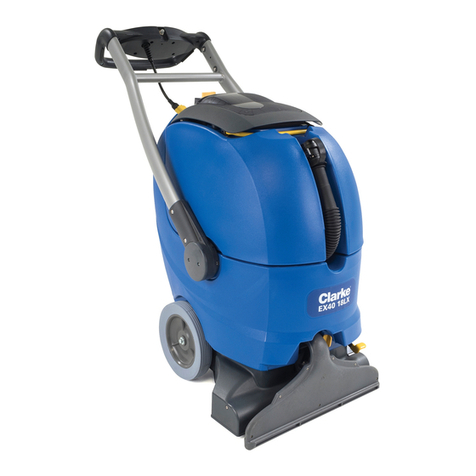
Nilfisk-Advance
Nilfisk-Advance Clarke EX40 18LX Instructions for use
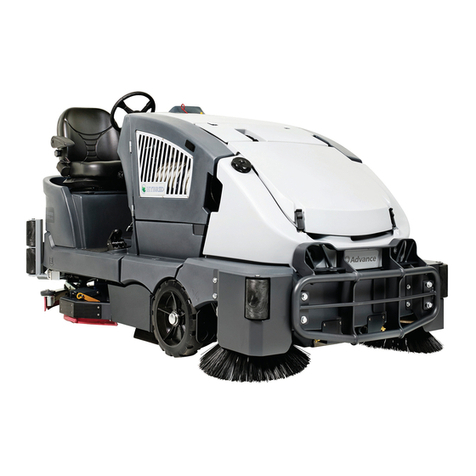
Nilfisk-Advance
Nilfisk-Advance Advance SC901 Instructions for use

Eagle power
Eagle power Panther 28 Service manual

Nilfisk-Advance
Nilfisk-Advance 56265002 Original instructions
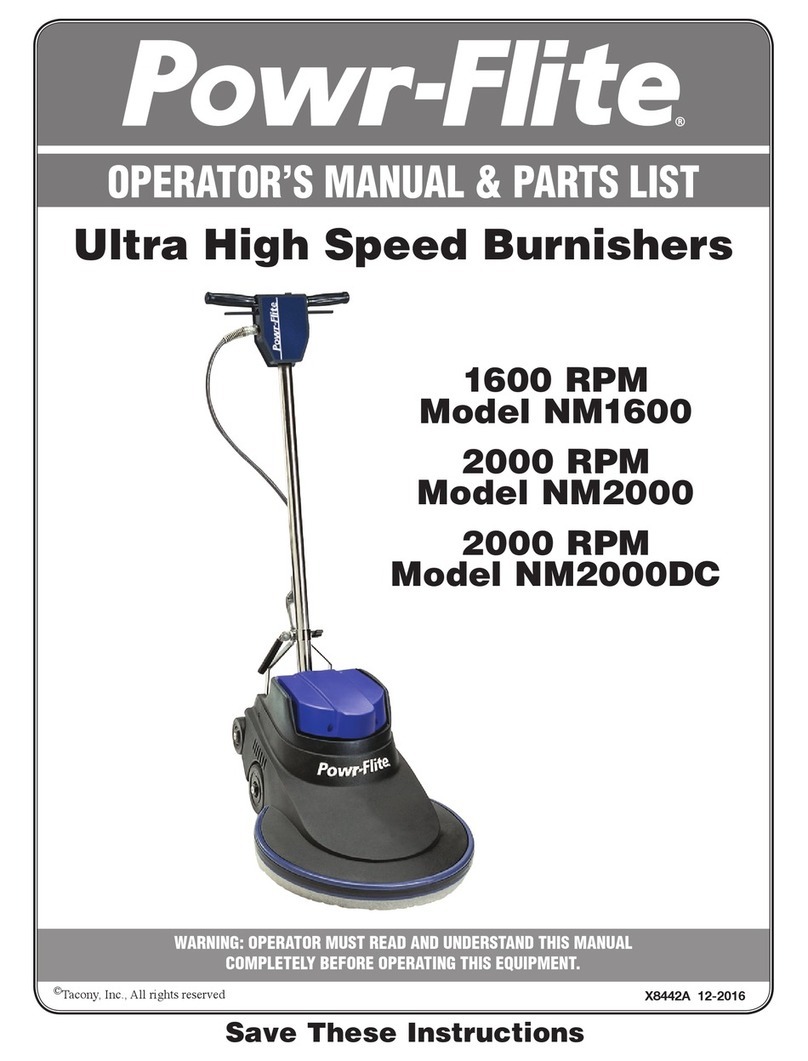
Tacony
Tacony Powr-Flite NM2000 Operator's manual & parts list

IP CLEANING
IP CLEANING 1250 Operator's manual
